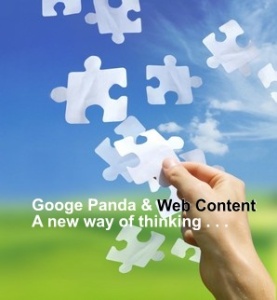The Philosophy of Panda
 Web Content – The Philosophy of Panda
Web Content – The Philosophy of Panda
Web Content and SEO
The thinking behind the Google Panda algorithm changes are fundamentally based on the input from Google’s human Quality Raters. Google found that they could put websites into two main categories which were sites that their Quality Raters liked and sites that they did not like.
The questions that Google asked their Quality Raters to think about when viewing a website were questions such as:
Would you trust this site with your credit card?
Do you like the design of this site?
Is the content on this site well written?
Do you want to remain on this site looking for other valuable, entertaining or notable content?
Google then replicated the ability to place sites into these 2 main categories by using an algorithm. The Google Panda Algorithm was introduced.
The introduction of the Panda Algorithm and the iterations of this algorithm over the past 1.5 years do change the way we need to think about website layout, web content and the website SEO that goes along with these items.
Prior to Panda, SEO Work could follow this step-by-step approach.
- Conduct key word research
- Write great content and lace the important keywords from the research into the content
- Make the content accessible to the search engines
- Get links to the content and the website in general
However, now a key differentiate for high search placement is “the user’s experience” and Panda’s ability to judge the user’s experience.
What is the main factor to define a great user experience? It still all relates to Content. However, now a specific aspect of content is judged based on other factors not related exactly to that specific web content item. You could have a great article and bad or confusing navigation and the quality of the article is diminished. You could have some great images and web copy on a page with a broken link and then that specific item of web content will have less positive impact. You may have spent significant time on your home page but much less time on the quality of other pages and the home page will not carry much weight in search because of the low quality of other pages on the site.
What does it mean to have great content?
Great content means to have content that delights people. It means that people love the content. They love the content so much that they indicate how much they love it in some of or many of the following ways:
- They blog about it
- They share it by passing it on to others.
- They bookmark it
- They stay on the page
- They look at multiple pages on the same site.
- They click through to the page when it is presented in search.
- They do not immediately return to the search results after visiting the page.
To create great content you need to have original content that makes people say “WOW!”. The tools to create great content are now readily available. There are people creating some great and amazing content on the web. Are you one of them or is your content boring? Does your website have a modern design and easy-to-use navigation? How would you judge the quality of your photos and graphics?
Do you have a proper content mix that relates to your target audience? The content mix is the combination of text, photos, internal links, videos, etc that you can place on your site to attract people and the search engines and get them to stay on your site and recommend your content to others.
Do you have authoritative content that has depth and variety? If your web content is shallow and without authority then this works against you.
Of course, Google is not disclosing the actual ranking signals used in their algorithms because they don’t want folks to game their search results; but if you want to step into Google’s mindset, the questions Google provides as guidance to their Quality Rankers can provide guidance to us as well.
If you want to view the entire list as it is presented in Google Webmaster tools then click on this link – Web Content Guidelines from Google.
